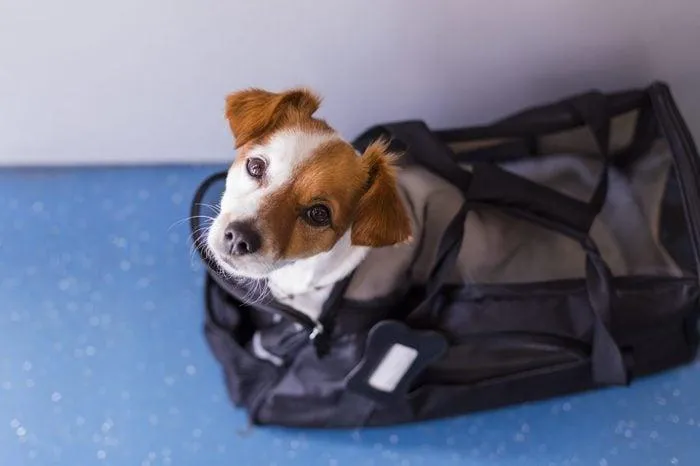A Comprehensive Guide to Bringing Your Small Dog on a Plane
Have you ever wondered if you can take Fido flying with you? The short answer is yes, many domestic airlines allow small dogs to travel in the cabin of passenger planes. However, there are some important rules and considerations to be aware of before you pack your pup’s favorite toy in your carry-on. In this article, I’ll breakdown everything you need to know to determine if bringing your small canine companion onboard is a good option for your upcoming trip.
Airline Pet Policies
- Check the pet policies for the specific airline(s) you will be flying. The major U.S. carriers – American, Delta, United – all permit small dogs to travel in-cabin, but have size and weight limits.
- Dogs must be able to fit comfortably in a pet carrier that can fit under the seat in front of you. Most allow carriers up to 18x14x8 inches.
- Weight limits are typically around 20 pounds or less, though some airlines have lower limits of 15 pounds or fewer.
It’s important to verify your dog meets the size and weight restrictions before booking your pet ticket. The last thing you want is showing up to the airport only to be told your furry friend is too big to fly inside the cabin.
Pet Carriers
Your pup will need to travel in an FAA-approved soft-sided or hard plastic carrier. From my experience, look for these key features:
- Sturdy and secure for takeoff/landing vibrations and unexpected turbulence.
- Ventilated for airflow and your dog’s comfort during the entire flight.
- Zip top closure for safety during taxiing, takeoff, landing.
- Comfortable carrying handles for you to haul through the terminal.
I highly recommend getting the carrier well in advance and letting your pet get used to it at home before travel day. The last thing you want is a stressed out pup on the plane!
Health Requirements
All domestic air carriers require pet owners to present a health certificate from a licensed vet. Typically this must be issued within 10 days of your flight and certify that your pooch:

- Is up to date on all vaccinations including rabies.
- Is free of fleas, ticks and internal/external parasites.
- Has received veterinary exam and is deemed fit to travel.
Some key Caribbean and international destinations may have even stricter pet import requirements involving health paperwork, microchipping and pre-travel quarantine. Be sure to research regulations for your entire itinerary well in advance.
Booking and Paperwork
Once you’ve selected your airline and verified your pup meets size limits, it’s time to reserve their seat and submit any required travel documents. Basic steps include:
- Book pet ticket when reserving your own seat or contact airline directly for assistance.
- Pay any applicable pet transportation fees (typically $125 each way for domestic flights in the U.S.).
- Complete an Animal Manifest form provided by the airline.
- Carry vet health/vaccination records on your person during travel.
Proper paperwork is key to avoiding delays or headaches at the airport. I always pack original documents plus photo copies in my carry-on and checked bag just in case.
In-Cabin Travel Tips
Once onboard, here are some tips to help your pooch achieve maximum comfort based on my own experiences traveling with puppers:
- Bring water, small toys/treats to help keep them calm during takeoff/landing.
- Consider anti-anxiety aid from vet for especially nervous fliers.
- Bring pee pads in case of emergency and dispose of soiled ones promptly.
- Talk with flight crew if puupper seems distressed – they may be able to assist.
- Be prepared to stow carrier under seat quickly for meals/beverage service.
Patience and positive reinforcement go a long way to make it an enjoyable experience for dog and owner alike!

Alternatives If Your Dog Is Too Big
If Fido exceeds size/weight restrictions, don’t despair! Here are some other pet-friendly transportation options to consider:
- Book pet as cargo on certain flights. There are more regulations but larger dogs are accommodated.
- Travel by car and break up driving time with rest stops to let them stretch their legs.
- Look into commercial pet transport services that arrange private ground transportation door-to-door.
- Consider boarding your pet professionally near family/friends to visit them instead of bringing your dog along.
With advance planning and following airline guidelines closely, most small canine companions can enjoy flying just like the rest of the family. But be sure to evaluate what’s safest and least stressful for your particular pup. Their comfort should be the top priority.
Final Thoughts
To summarize the main points covered in this guide:
– Check specific airline policies on pet travel
– Ensure your dog meets size/weight restrictions
– Prepare required paperwork and health records well in advance
– Acclimate your pup to an approved carrier
– Pack essential supplies and know in-cabin guidelines
– Consider ground or commercial transport if dog is too big to fly
By doing your homework and knowing both airline procedures and your pet’s needs, you can feel more confident about the decision whether bringing Fido in the cabin is the right choice for your upcoming journey. With careful planning and precautions, it can be a positive experience for owner and dog alike. Let me know if you have any other pet travel questions!

Guidelines for Bringing Small Dogs on Commercial Flights
| Airline | Size/Weight Limit | Cabin or Cargo | Container Required | Fees |
|---|---|---|---|---|
| American Airlines | Less than 20 lbs | Cabin (under seat) | Soft-sided carrier | $125 each way |
| Delta | Less than 20 lbs | Cabin (under seat) | Hard- or soft-sided carrier | $125 each way |
| United | Less than 20 lbs | Cabin (under seat) | Hard- or soft-sided carrier | $125 each way |
| Southwest | Less than 20 lbs | Cabin (under seat) | No carrier required | $95 each way |
| JetBlue | Less than 20 lbs | Cabin (under seat) | Soft-sided carrier | $100 each way |
FAQ
-
Can I bring my small dog on the plane in the cabin?
Generally, yes – most airlines allow you to bring small dogs in the cabin as carry-on bags as long as the dog is able to fit comfortably under the seat. However, certain restrictions may apply depending on the specific airline. Be sure to check their policies in advance.
-
What size restrictions are there for dogs on planes?
The maximum size limits vary by airline, but most allow dogs that are 20 lbs or less and can fit in an approved carrier that fits under the seat in front of you without blocking the aisle. Basically, if your pup is sort of little and super portable, then they’re usually fine. But you’ll wanna double check with your airline first.
-
Do I need to buy my dog a ticket?
Yup, Fido will need his own plane ticket just like the rest of the passengers. Ticket prices for animals are often lower than for people though. Most airlines charge around 5 each way for pets to fly as cargo or in the cabin. At the same time, you’ll need to bring your dog’s carrier too, so consider if the added cost is worth it.
-
What paperwork is required?
strong>Airline regulations require that you bring proof of current vaccinations and veterinary records for your pup. You’ll need a health certificate signed by your vet stating that your dog is fit to fly. Some airlines may ask for additional documents too, so it’s best to check with your specific carrier ahead of time to be safe. Proper paperwork helps ensure everyone’s safety and comfort during the flight.
-
Can I sit with my dog on my lap?
This varies by airline, but many will allow small dogs to remain in your lap throughout the flight rather than being stowed under the seat, which can perhaps put your mind more at ease. Nevertheless, you’ll want to double check the carrier size limits and policies for your airline just to be sure. And of course, keep your pup securely contained if it’s wiggly or anxious.

-
What if my dog acts up on the plane?
If for some reason your furry friend gets riled up and disruptive in flight, the crew may ask you to put them in their carrier or move to another seat. Most pups keep calm, but if yours tends to be high strung, it’s best to consider sedative medication or not bringing them at all. You don’t want to risk disturbing other passengers or having an “incident” at 30,000 feet!
-
Any tips for making my dog comfortable?
A few things that can help put your pup at ease include keeping them in a familiar carrier, giving them a cozy blanket that smells like home, bringing tasty treats to distract them, and maybe consider calming aids like pets CBD oil or calming vest. Talk to your vet for the best solution. Comfort is key, so do whatever you can to minimize your dog’s stress.
